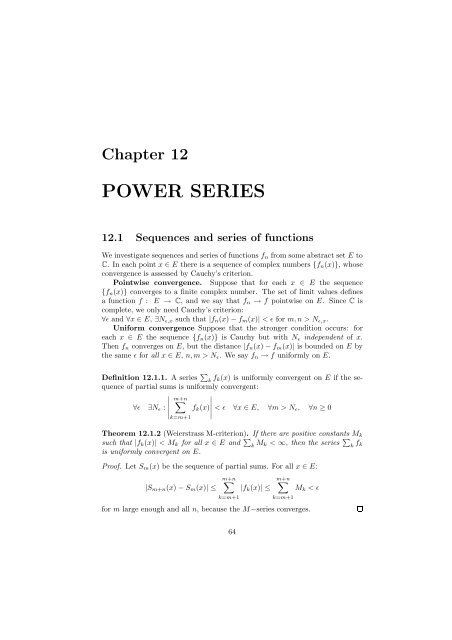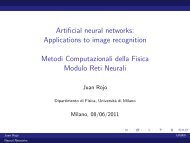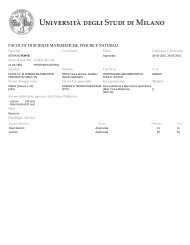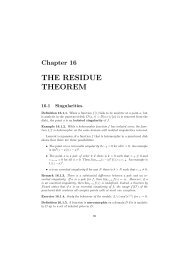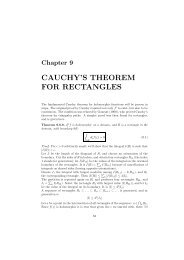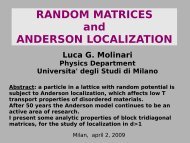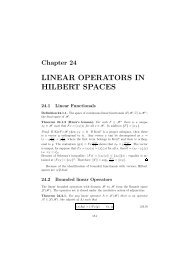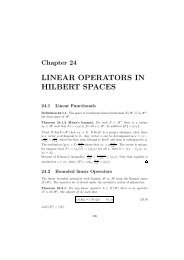POWER SERIES
POWER SERIES
POWER SERIES
- No tags were found...
Create successful ePaper yourself
Turn your PDF publications into a flip-book with our unique Google optimized e-Paper software.
Figure 12.1: Karl Weiertrass (1815, 1897) was professor in Berlin. His fameas a lecturer attracted several students: Cantor, Frobenius, Fuchs, Grassmann,Killing, Mertens, Kovalewskaya, Runge, Schur, H. A. Schwarz. He did notbother much about priorities, and published many results late in his career.From now on, the set E is a domain (open connected set) in C. The uniformconvergence of a series guarantees that integration can be made term by term:Theorem 12.1.3 (Integral of series). Given a piecewise smooth curve γ in adomain D, a sequence of functions {f k } continuous on D, suppose that theseries ∑ k f k is uniformly convergent to g on γ. Then∞∑∫ ∫dζf k (ζ) = dζg(ζ) (12.1)k=0γProof. Uniform convergence on γ means that |S m (z) − g(z)| < ǫ for all m > Nand for all z ∈ γ. The partial sums S m (z) are continuous functions on γ,which is a compact set, then uniform convergence implies that the limit g(z)is continuous on γ. Finally, Darboux’s inequality shows that summation andintegration commute:m∑∫ ∫dζf∣ k (ζ) − dζg(ζ)γγ ∣∫γ≤ |dζ| |S m (ζ) − f(ζ)| < ǫ L(γ)kγRemark. Uniform convergence of sequences (or series) is too a restrictivecondition. Theorem 12.1.3 and other ones, as derivation of a series term byterm, can be proven under the weaker hypothesis of local uniform convergence(normal convergence) presented in the Appendix.65
12.2 Power seriesA fundamental class of series of functions are power series,∞∑f(z) = c n (z − a) n (12.2)n=0a ∈ C is the center of the power series. The geometric and exponential seriesare examples of power series. Both series are absolutely convergent, the first inthe open disk |z| < 1, the second everywhere.In the following we put a = 0, and results remain valid with a shift to a ≠ 0.Theorem 12.2.1 (Abel, Weierstrass). If the power series ∑ k c kz k is convergentin a point z 0 , then the series converges absolutely at all z in the opendisk |z| < |z 0 |. Convergence is uniform for |z| ≤ (1 − η)|z 0 |, η > 0.Proof. Convergence of the series in z 0 implies that |c k z0 k | → 0; then, for klarge enough, it is |c k ||z 0 | k < ǫ. If |z| < |z 0 | the Cauchy criterion for absoluteconvergencem+n∑k=m+1|c k z k | ≤ ǫm+n∑k=m+1∣ z ∣∣∣k∣ ∣ < ǫz ∣∣∣m+11z 0∣z 0 1 − |z/z 0 |is satisfied for m large enough; then the series converges absolutely. If |z| ≤(1−η)|z 0 | it is |c k z k | < ǫ(1−η) k . Then the convergence is uniform by WeierstrassM-test.The theorem shows that one of the three mutually exclusive possibilitiesmust hold:• z 0 = a is the only point where the series converges.• There are points z 0 ≠ a where the series converges, but the series divergesin other points.• The series converges for any finite z 0 .The Abel Weierstrass theorem shows that convergence occurs in any open diskcentered in a of radius less than |z 0 − a|. Case two then implies the existence ofa disk |z −a| < R inside which the series converges absolutely, and uniformly inany closed disk strictly contained in it, and diverges in |z − a| > R. The valueR is the radius of convergence of the series. If R = ∞ the series convergesabsolutely everywhere, and uniformly in any bounded set.In general nothing can be said about the series on the circle |z − a| = R 1 .We give two important formulae for the determination of the radius, whichresult from the general criteria for absolute convergence of series.1 However, if the series converges in a point z 0 with |z 0 −a| = R, a theorem by Abel provesthat on the radius ζ(t) = a + (z 0 − a)t (t ∈ [0,1]) the series f(t) = P c k (z 0 − a) k t k convergesuniformly with respect to t and lim t→1 f(t) = f(1).66
Proof. For any z ∈ D (|z − a| < r) it is∫dζ f(ζ)f(z) =2πi ζ − zCauchy’s kernel is expanded in geometric series,C1ζ − z = 1∞ζ − a − (z − a) = ∑ (z − a) k(ζ − a) k+1 (12.6)The sum can be taken out of the integral because the series converges uniformlyin the interior of the disk.Corollary 12.2.10. A holomorphic function can be differentiated indefinitelyand∫f (k) dζ f(ζ)(a) = k!2πi (z − a) k+1 (12.7)C ( a,r)Darboux’s inequality gives Cauchy’s Inequalityk=0|f (k) (a)| ≤ k!r k sup |f(a + re iθ )| (12.8)θ∈[0,2π]The radius of convergence of the power series centered in a of an analyticfunction is the largest admissible radius of a disk centered in a in the domainof analyticity: R = |ξ − a| where ξ is the singular point or branch cut pointnearest to a.Example 12.2.11. The function f(z) = [(z 2 − 2i)(z − 3)] −1 is singular atz = ± √ 2e iπ/4 and z = 3. A power expansion in the origin has radius √ 2. Anexpansion with center in a = 2 − 2i has radius √ 5 = |3 − (2 − 2i)| because 3 iscloser to 2 − 2i than ± √ 2e iπ/4 .Example 12.2.12. The function f(z) = Log z has the cut (−∞, 0]. The radiusof an expansion in powers of (z − a) depends on a: if Re a > 0 the radius isR = |a| (the least distance of a from the cut); if Re a < 0 this least distance isR = |Im a|. Inside the disk D(a, R) the function Logz is analytic, andLog z = Log [a + (z − a)] = Log a + Log(1 + z − aa )∞∑ (−1) k+1= Log a +ka k (z − a) k (12.9)where we used the reference expansion which is obtained by integrating term byterm the geometric series (1 − z) −1 = ∑ k zk ,k=1Log(1 − z) = −z − z22 − z3− . . . |z| < 1 (12.10)368
Exercise 12.2.13. From the expansion of Log(1 − z) in |z| < 1 obtain:∞∑k=1ρ kk cos(kθ) = −1 2 log(1 − 2ρ cosθ + ρ2 )Example 12.2.14. Evaluate the coefficients of the power seriese tz ∞1 − z = ∑n=0c n (t)z nIt is convenient to compare the series e tz = (1−z) ∑ n c nz n = ∑ n zn (c n −c n−1 ),with c 0 = 1, c −1 = 0. This gives the recursive rule c n − c n−1 = t n /n! i.e.(partial sums of exponential series).c n (t) = 1 + t + t22! + . . . + tnn!Example 12.2.15. Evaluate the coefficients of the power series1∞z 2 − z − 1 = ∑c n z nThe radius of convergence of the series is dictated by the size of the smallestroot of the binomial: R = 1 2 (√ 5 − 1). The quick way to obtain the coefficientsis to write the l.h.s. as a combination of two geometric series. However, thefollowing procedure is interesting.Multiply the series by the denominator to get 1 = ∑ n zn (c n−2 − c n−1 − c n )i.e. c n = c n−1 + c n−2 and c 0 = 1 (c −1 = 0). The recursion generates theFibonacci numbers 1, 1, 2, 3, 5, 8, 13, . . .. The general solution can be found: c n =Ax n 1 + Bxn 2 , where x 1,2 solve the quadratic equation x 2 − x − 1 = 0 and A, Bare specified by the initial conditions.If x 1 is the root with largest modulus, Hadamard’s criterion for the radius of thepower series gives 1/R = |x 1 |, i.e. R = |x 2 | (note that x 1 x 2 = 1).The recursion can be written (c n /c n−1 ) = 1 + (c n−2 /c n−1 ). In the large n limitc n /c n−1 → φ and φ = 1 + 1/φ. (then, by the ratio criterion, R = 1/φ). Thenumber φ = 1 2 (√ 5+1) is the golden mean, and is the limit of ratios of Fibonaccinumbers. Its partial fraction expansion is peculiar: φ = 1+1/(1+/(1+/(1+. . .)and makes this number the “most irrational” one (Hurwitz developed a theoryfor rational approximation of irrationals).Example 12.2.16. Evaluate the coefficients (Euler numbers) of the power series1∞cosz = ∑(−1) n z 2nE 2n(2n)!n=0The radius of convergence of the series is π/2 (the pole closest to the origin).This gives us the estimate |E 2n | ≈ (2n)!(2/π) 2n . Multiplication by cosz gives an=069
Cauchy product of series:1 =∞∑k=02k (−1)kz(2k)!k∑l=0( ) 2kE 2l2lComparison of polynomials in z gives, for the power k = 0: E 0 = 1. Higherpowers are absent in the l.h.s. therefore:k∑l=0( ) 2kE 2l = 0, k ≥ 12lExample 12.2.17. Evaluate the coefficients (Bernoulli numbers) of the powerseriesz∞e z − 1 = ∑ z nB nn!n=0The radius of convergence of the series is 2π. If we subtract the series expansionfor −z we get −z = ∑ n B n(1 − (−1) n )z n /n!. Therefore B 1 = −1/2 andB odd>1 = 0. Let us then rewrite the series:z2 coth z ∞ 2 = ∑ z 2nB 2n(2n)!n=0(12.11)Multiplication by cosh(z/2) gives a Cauchy product of series, and recursion relationsfor Bernoulli numbers 2 .Bieberbach’s conjecture (1916): if f(z) = z + a 2 z 2 + a 3 z 3 + . . . convergesin the disk |z| < 1 and is injective on the open disk (univalent), then |a 2 | ≤ 2,|a 3 | ≤ 3, |a 4 | ≤ 4 etc.Bieberbach proved that |a 2 | < 2, then Loewner proved that |a 3 | < 3 by meansof Loewner’s differential equation. The conjecture was proven by de Branges in1984. The limit case, with real coefficients, is the expansion of Koebe’s function:K(z) = z + 2z 2 + 3z 3 + 4z 4 + . . . = z d dz (1 + z + z2 + . . .) =z(1 − z) 2w = K(z) maps univalently the unit disk to the plane with cut Re w < −1/4.The cut is the image of the unit circle: if z = e iθ then w = −[2 sin(θ/2)] −2(θ ≠ 0).2 The Bernoulli numbers were discovered almost at the same time in Japan, by Seki Kowa(1640, 1708), the most eminent Wasan (Japanese calculator)70
12.3 Generating functions and polynomials12.3.1 Hermite polynomialsThe function H(z, x) = e −z2 +2xz is entire for any value x ∈ R, and can beexpanded in power series of z with center z = 0e −z2 +2xz =∞∑k=0H k (x) zkk!(12.12)The coefficients are functions of x. It is instructive to evaluated them by themethods introduced so far. Being coefficients of a power series, they can beevaluated as contour integrals around the origin:∫H k (x) = k!Cdζ e −ζ2 +2xζ2πi ζ k+1 = k!∞∑ (2x) l ∫l=0l!Cdζ2πi e−ζ2 ζ l−k−1Since terms with l ≥ k + 1 vanish because of Cauchy’s theorem for entirefunctions, H k (x) turns out to be a polynomial of degree k (Hermite polynomial).The function H(z, x) is the generating function of Hermite polynomials andencodes their analytic properties.The evaluation can proceed further. The coefficients of the power expansionof the entire function e −z2 = ∑ k c 2kz 2k are known and can be evaluated asintegrals:c 2k = (−1)kk!∫=while coefficients c 2k+1 vanish. Therefore:H k (x) = k!k∑ (2x) l ∫l=0[k/2]∑= k!l=0[k/2]∑= k!l=0l!C(2x) k−2l ∫(k − 2l)! C(2x) k−2lCdζ2πi e−ζ2 ζ l−k−1 = k!dζ2πi e−ζ2 ζ −2l−1(−1) ll!(k − 2l)!dζ2πi e−ζ2 z −2k−1k∑l=0(2x) k−l ∫dζζ −l−1(k − l)! C 2πi e−ζ2(12.13)where [k/2] is the integer part of k/2. The last formula gives the explicit expressionof Hermite polynomials.We learn a lot from the generating function: the change z to −z in (12.12)is compensated by x to −x, then Hermite polynomials have definite parity:H k (−x) = (−1) k H k (x).The two identities ∂ x H(z, x) = 2zH(z, x) and ∂ z H(z, x) = 2(−z + x)H(z, x),71
when translated to the power series expansion 3 , give the useful recurrence relationsH ′ k(x) = 2k H k−1 (x), H k+1 (x) = 2xH k (x) − 2k H k−1 (x) (12.14)with initial conditions H 0 (x) = 1 and H 1 (x) = 2x that can be obtained by handfrom the expansion of H(z, x).The identity (2z∂ z − 2x∂ x − ∂x 2 )H(z, x) = 0 corresponds to the second orderequation (which has another non-polynomial independent solution)H ′′k − 2xH ′ k + 2k H k = 0The Hermite polynomials can be evaluated by the generating function (Rodrigues’formula 4 )[ ∂kH k (x) =∂t]t=0k H(t, x) ∂k x2=[e∂t]t=0k e−(t−x)2 = (−1) k dk x2edx k e−x2The integral ∫ ∞−∞ dxe−x2 H k (x)H j (x) is symmetric in k and j. We evaluate itfor k ≥ j by using Rodriguez’s formula for H k (x), and doing k integration byparts:∫ ∞−∞dxe −x2 H k (x)H j (x) = (−1) k ∫ ∞=∫ ∞−∞−∞dxH j (x) dkdx k e−x2dk −x2dxedx k H j(x) = 2 k k! √ π δ jk (12.15)because H k (x) = 2 k x k + . . . (use eq.12.14). This is the orthogonality propertyof Hermite polynomials.The Cauchy product H(z, x)H(z, y) = H(z √ 2, x+y √2) gives an interesting summationformula (by equating the coefficients of equal powers of z):k∑l=0( ( )k x + yH l (x)H k−l (y) = 2l)k/2 H k √2Exercise 12.3.1. Evaluate the Cauchy product of the exponential series fore −z2 and e 2tz and obtain the absolutely convergent power series of the generatingfunction (12.12).There are several other generating functions whose power series expansionyield special functions that are important in mathematical physics 5 . Some examplesare briefly presented below, some will be considered in the study oforthogonal polynomials (Ch. on Hilbert spaces).3 Derivation of the series term by term is possible because it is uniformly convergent bothin z and x, in any compact set.4 Olinde Rodrigues (1795, 1851)5 A beautiful little book on special functions is: N. N. Lebedev, Special functions and theirapplications, Dover Ed. A modern reference book is the NIST Handbook of MathematicalFunctions, Cambridge Univ. Press.72
12.3.2 Legendre polynomialsConsider the function P(z, x) = (1 −2xz +z 2 ) −1/2 . The quadratic function hasroots z < + z > = x and z < z > = 1 where z < is the one with smaller modulus. Inthe disk |z| < |z < | the function P(z, x) is analytic and can be expanded in z:1√ = ∑∞ z k P k (x) (12.16)1 − 2xz + z2The coefficients P k (x) are evaluated by a Cauchy integral and are polynomials oforder k (Legendre’s polynomials). The generating function and the polynomialsare relevant in the theory of orbital angular momentum, or for the multipoleexpansion of 1/r potential:1|⃗r − R| ⃗ = 1√R2 − 2Rr cosθ + r = 1 2 Rk=0∞∑ ( r) lP l (cos θ) R > r (12.17)Rθ is the angle between the vectors. From the identities (1−2xz+z 2 )∂ z P(z, x) =(−z + x)P(z, x) and (1 − 2xz + z 2 )∂ x P(z, x) = zP(z, x) one derives recurrencerelations for the polynomials. Much more can be obtained with the techniquesillustrated above.12.3.3 Laguerre polynomialsThe function L(z, x) = (1 − z) −α−1 e −xz/1−z is analytic in the disk |z| < 1 andis the generating function of Laguerre’s polynomials:l=0xze −1 − z∞(1 − z) α+1 = ∑L α k(x)z k (12.18)The polynomials (and their derivatives) arise in the study of the radial equationfor Hydrogen atom.k=012.3.4 Chebyshev polynomials4 − z 2 ∞4 − 4xz + z 2 = ∑T k (x) znn!k=1(12.19)12.3.5 The Hypergeometric series∞∑ a n b n z nF(a, b; c; z) =c n n! = 1 + abc z + 1 a(a + 1)b(b + 1)z 2 + . . . (12.20)2! c(c + 1)n=0c ≠ −1, −2, . . .. a n = a(a + 1) · · ·(a + n − 1) is Pochammer’s symbol; for apositive integer k it is (−k) k+1 = 0. Then a series F(−k, b; c, z) terminates and73
is a polynomial of degree k in z. Note the symmetry in a and b.By the ratio test the hypergeometric series is convergent for |z| < 1:(n + 1)! a n b n c n+1 (n + 1)(c + n)=n! c n a n+1 b n+1 (a + n)(b + n) → 1By assigning different values to a, b and c, the power expansions of severalimportant functions in mathematical physics are reproduced.E) Show that: ∂ z F(a, b; c, z) = (ab/c)F(a + 1, b + 1; c + 1; z), and that thehypergeometric function F(a, b; c; z) is a solution of the differential equationz(z − 1)F ′′ (z) + [c − (a + b − 1)z]F ′ (z) − abF(z) = 0Appendix: normal convergenceDefinition 12.3.2. A sequence of functions {f n } converges normally to f ona domain D if it converges pointwise to f on D and, for any z ∈ D there is aclosed disk centered in z where convergence is uniform.Theorem 12.3.3 (Integral of series). Given a piecewise smooth curve γ and asequence of continuous functions {f k } on D, suppose that the series ∑ k f k(z) =f(z) is normally convergent to f on γ. Then∞∑∫k=0γ∫dζf k (ζ) =γdζf(ζ) (12.21)Theorem 12.3.4. If the sequence {f k } is normally convergent to f on a domainD and all functions f k are holomorphic, then f is holomorphic and the sequenceof derivatives {f (n)k} converges to f(n) normally.Theorem 12.3.5 (Derivative of series). If the series ∑ k f k(z) = f(z) is normallyconvergent on a domain D, and every term f k is holomorphic on D, thenf is holomorphic on D. Moreover, the series can be differentiated term by termany number of times:∞∑k=0f (n)k(z) = f (n) (z), n = 1, 2, . . . (12.22)for all z ∈ D, and each differentiated series is normally convergent.74


